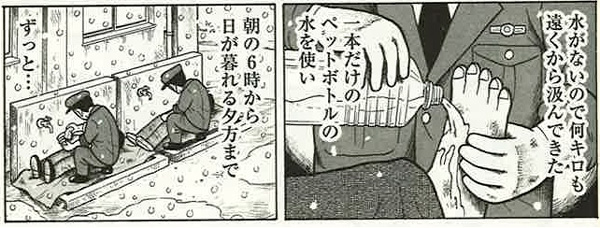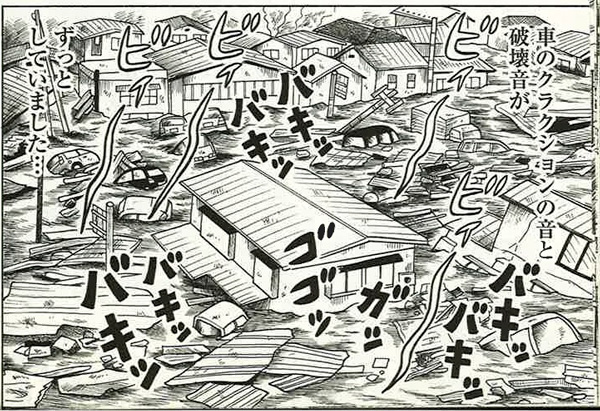311 Japanese Curricular Resources Project
What is the 311 Japanese curricular resources project?
The 311 Japanese curricular resources project at the Inter-University Center for Japanese Language Studies has created Japanese language teaching materials related to the March 11, 2011, disaster and made those materials available online. Persons who are learning Japanese language or who wish to learn about Japan may use these materials freely. We hope these resources will facilitate both language learning and understanding of Japanese culture.
On March 11, 2011, Japan was struck by an earthquake of unprecedented proportions. The magnitude-9.0 earthquake centered in northeastern Japan and the tsunami and Fukushima nuclear accident that followed resulted in the deaths of more than 20,000 people. Today, there are still over 25,000 people that remain displaced.
The tremendous impact of the disaster was felt both socially and culturally and continues to linger today. The force and extent of that impact far exceeds the physical damage done by the earthquake and tsunami themselves. It is even said that the impact of 311 caused transformations of Japanese society and culture.
We believe it crucial for all who are involved in Japan and Japanese scholarship to study the Great East Japanese Earthquake, which had such a significant impact on Japan.
With this goal in mind, we have created a set of Japanese language curricular resources based on the March 11 disaster. We hope this project, which is ongoing, will be put to use by as many people as possible. We expect to keep adding to the curricular resources that can be used.
This project was made possible by a grant from the United States-Japan Foundation. We wish to express our sincere thanks for their support.
Publications and presentations by project team members
- January 2013
- Ari Sato, “Our efforts to respond to Japan’s 2011 disasters and future possibilities: Limitations and possibilities of the Digital Archive from the viewpoint of the Japanese language education field,” at the conference “Opportunities and Challenges of Participatory Digital Archives: Lessons from the March 11, 2011 Great Eastern Japan Disaster,” Reischauer Institute of Japanese Studies, Harvard University, January 24–25, 2013.
- March 2013
- Soichi Aoki, 「311に関する包括的日本語教材の作成」 (Developing language teaching materials to provide a comprehensive approach to teaching about the 3/11 disasters), at the American Association of Teachers of Japanese 2013 Spring Conference, San Diego.
- September 2013
- Soichi Aoki, “Japanese Language Teaching Materials to Provide a Comprehensive Approach to the Teaching of 3/11-Related Events: Beyond the Insider/Outsider Dichotomy,” at the IUC 50th Anniversary Symposium, Stanford University, September 7, 2013.
THE HIGH SCHOOL 3-11 PROJECT
The High School 3-11 Project is a collaborative undertaking to create curricular materials for teaching Japanese language to non-Japanese high school students. These materials are based on one part of the Japanese language teaching resources relating to the Great East Japan Earthquake and Tsunami of March 11, 2011, that were developed by the Inter-University Center for Japanese Language Studies (IUC), Yokohama.
In the High School 3-11 Project resources, we used a selection from Hirai Toshinobu’s manga 3-11 Higashi Nihon Daishinsai: Kimi to mita fūkei (The Great East Japan Disaster of 3.11: Scenes I Saw with You) as a basis for creating materials for learning—among other things—onomatopoetic expressions.
All of us who were involved in this project wish to express sincere gratitude to the United States-Japan Foundation, which provided funding support for the development of these resources.
Project Manager: Norman T. Masuda
Collaborators: Koichi Sano, Joanne Akamine
Financial Assistance: The United States-Japan Foundation
3/11 and Manga
 |
| Koji Yoshimoto, Santetsu: Japan Travel Railroad Atlas- Sanriku Railway - Records of the Great Earthquake (Shinchosha) |
These curricular materials feature manga related to the Great East Japan Earthquake and encourage students to consider the expressive medium of manga.
① Hirai Toshinobu, 3/11 Great East Japan Earthquake: What You and I Saw (Excerpts)
 |
| Hirai Toshinobu, 3/11 Great East Japan Earthquake: What You and I Saw (Bunkasha) |
We selected “Omens” and “The Earthquake Strikes” from 3/11 Great East Japan Earthquake: What You and I Saw by Hirai Toshinobu. We encourage students to think about the differences between what they’ve read or heard until now about the day of the earthquake and what they read and understand about the day of the earthquake from this manga. How do those differences relate to manga as a medium?
Through the kindness of author Hirai Toshinobu as well as everyone in the editorial department at Bunkasha, we received permission to reprint/reproduce these pages free of charge. We wish here to offer our sincere thanks.
Hirai Toshinobu 3/11 Great East Japan Earthquake: What You and I Saw (Bunkasha)
©TOSHINOBU HIRAI / BUNKASHA
② Yoshimoto Koji, Santetsu (Excerpts)
 |
| Yoshimoto Koji Santetsu: Japan Travel Railroad Atlas - Sanriku Railway - Records of the Great Earthquake (Shinchosha) |
From Santetsu by Yoshimoto Koji, we excerpted portions from “That Day, That Time” and “Until Spring Comes.” We encourage students to think about the differences between what they’ve read and seen until now about the tsunami and what they read and understand about the tsunami conditions from this manga. We also encourage students to think about the medium of manga and what is being expressed therein.
Through the kindness of author Yoshimoto Koji as well as everyone in the editorial department at Shinchosha , we received permission to reprint/reproduce these pages free of charge. We wish here to offer our sincere thanks.
Yoshimoto Koji Santetsu: Japan Travel Railroad Atlas - Sanriku Railway - Records of the Great Earthquake (Shinchosha)
©koji yoshimoto 2012/shinchosha. Co., Ltd
THE HIGH SCHOOL 3-11 PROJECT
 |
| Hirai Toshinobu, 3/11 Great East Japan Earthquake: What You and I Saw (Bunkasha) |
These resources are for study of Japanese language by high school students, based on a selection from manga artist Hirai Toshinobu’s 3-11 Higashi Nihon Daishinsai: Kimi to mita fūkei (The Great East Japan Disaster of 3.11: Scenes I Saw with You). They were developed for learning—among other things—onomatopoetic expressions.
In addition to the manga itself, a vocabulary list, and a list of onomatopoetic words, we have prepared classroom teaching methods, a PowerPoint presentation explaining onomatopoeia, and Can-Do-Statements for use after the class has been taught. For further details, please refer to “HIGH SCHOOL 3-11 PROJECT—INTRODUCTION.”
Project Manager: Norman T. Masuda
Collaborators: Koichi Sano, Joanne Akamine
Financial Assistance: The United States-Japan Foundation
IUC High School 3-11 Project for High School Students
We are deeply grateful to Hirai Toshinobu, the author of 3-11 Higashi Nihon Daishinsai: Kimi to mita fūkei, and the editorial board of publisher Bunkasha for granting us permission to use images and text from 平井寿信『3・11東日本大震災 君と見た風景』ぶんか社, ©TOSHINOBU HIRAI / BUNKASHA on these pages.
Tragedy
Often many things are lumped together and reported as the Great East Japan Earthquake, a single large-scale disaster, but for each individual who suffered from it, it was a personal tragedy that absolutely cannot be generalized. In these curricular materials, from among the countless tragedies that occurred due to the Great East Japan Earthquake, we chose two instances that became particularly well-known and were frequently reported on.
We excerpted readings from the Kahoku Shimpo Press editorial deparment’s Rise Again! Kahoku Shimpo Press’ Records of the Great East Japan Earthquake (Chikuma Shobo). Through the kindness of everyone at Kahoku Shimpo Press, we received permission to reprint/reproduce these pages free of charge. We wish here to offer our sincere thanks.
©Kahokushimpo.Ltd. 2012
① The Minami-Sanriku Disaster Prevention Office Tragedy
Victims of the tsunami in Minami-Sanriku-cho included 566 dead and 310 missing. In this town, disaster prevention awareness was very high and they were always prepared for a tsunami. The Disaster Mitigation Office was the base of disaster mitigation, and immediately after the earthquake residents were urged to promptly evacuate to higher ground. However, the scale of the tsunami far exceeded predictions and wreaked havoc on the Disaster Mitigation Office, and many staff members who were implementing preventative measures lost their lives. Among the victims of the tsunami was a woman who continued to broadcast instructions to evacuate over the town’s wireless system. The story of her sacrifice moved many people’s hearts.
② The Okawa Elementary School Tragedy
It was at 2:45 in the afternoon on March 11th that the Great East Japan Earthquake occurred. Consequently, the earthquake struck when the majority of children were at school. Teachers played a key role in evacuating groups at each school, but more than a few children ended up victims. At Okawa Elementary School in Ishinomaki the tsunami hit as faculty and students were evacuating—out of 108 students, 74 (equivalent to about 70% percent) either perished or went missing, and that heartbreaking event became a major headline. Simultaneously, controversy arose about whether the proper instructions to evacuate were given or not.
The Great East Japan Earthquake: Reading newspaper headlines and leads
These teaching materials include articles on five topics: ① The Earthquake and Tsunami, ② The Fukushima Nuclear Power Plant Disaster, ③ Relief Efforts, ④ Refugees Unable to Return Home, and ⑤ Reactions from Overseas. We will study newspaper articles written at the time of the earthquake, come to understand fundamental information concerning the earthquake, and learn relevant terminology used to discuss the incident by reading articles from Yomiuri Shimbun, Asahi Shimbun, and The Nikkei (formally known as the Nihon Keizai Shimbun).
The purpose of these curricular materials is to teach the basic terminology that is needed to talk about the Great East Japan Earthquake, and to provide the background knowledge that, at a minimum, is necessary in order to understand the disaster. Mainly we will study headlines and ledes (opening paragraphs) of articles containing reportage of facts.
Under terms of agreements with the copyright owners, the IUC 311 Japanese Curricular Resources Project was permitted to make content from newspapers available for free download for one year. The period of permitted usage was from July 1, 2014, to June 30, 2015. We regret that we can no longer offer free download service. We wish once again to express our thanks to the U.S.-Japan Foundation for its support of this project, and to the teachers and learners of Japanese who have used these materials.
① The Earthquake and Tsunami
② The Fukushima Nuclear Power Plant Disaster
③ Relief Efforts
④ Refugees Unable to Return Home
⑤ Reactions from Overseas
The Great Eastern Japan Earthquake: Newspapers from the Following Day
In this section, we use a page from a newspaper published the day after the earthquake to consider how the disaster was initially understood and reported. The following articles were drawn from page 16 of the March 12, 2011, morning edition of the Yomiuri Shimbun. As study material, lists of important expressions and vocabulary have been prepared for each page and for the excerpts from and commentaries on the articles.
The purpose of these articles as teaching material is not just to understand the events of the March 11 earthquake through the lens of the following day’s newspaper, but also, at the same time, to study how news reportage developed in the period immediately after the disaster. We learn about changes in the way the disaster and the enormity of its impact were seen, and also about the chaotic conditions just after the event.
Under terms of agreements with the copyright owners, the IUC 311 Japanese Curricular Resources Project was permitted to make content from newspapers available for free download for one year. The period of permitted usage was from July 1, 2014, to June 30, 2015. We regret that we can no longer offer free download service. We wish once again to express our thanks to the U.S.-Japan Foundation for its support of this project, and to the teachers and learners of Japanese who have used these materials.
The 311 curricular resources project team wishes to thank Kenia Avendano, Chelsea Bernard, Robin Mitchell, and Jacob Ritter, members of the Class of 2014-15 at the IUC, for their assistance with English translation.
↑ページ先頭へ



